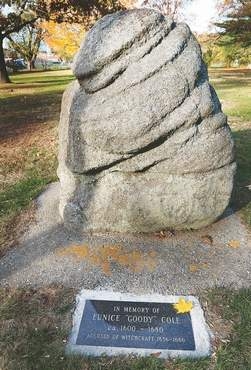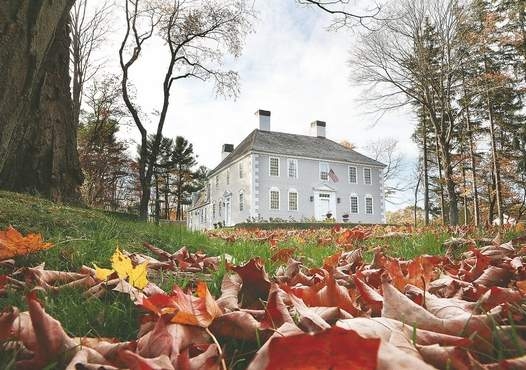Multiple town properties have a spooky history
By Rachel Follender
Hampton Union, October 29, 2013
[The following article is courtesy of the Hampton Union and Seacoast Online.]
HAMPTON — While the town may be best known for its beaches and boardwalk, there’s a spookier side of Hampton.
It’s a history that includes ghosts of Hampton’s past that continue to haunt the town’s streets.
Lightning strike
At 724 Lafayette Road in Hampton, a small granite staircase leads to the front door of a Yankee Trader Real Estate and bookkeeping office. On the second floor, there exists an old apartment in which a woman named Diane resides.
Although Diane lives in the apartment by herself, she feels as though she is not alone.
“She did it,” echoed a man’s voice in the upstairs hallway one afternoon, she said.
“I was moving a desk, and I heard someone yell ‘she took it, she did it,'” Diane said. “I think it was because I moved the desk out of the bedroom.”
Diane reports that over the years, she constantly hears whispering, feels a hand stroking her hair from time to time, and on occasion has felt the patter of something moving across her bed.
When she went downstairs to the bookkeeping office one day to talk to Sandra Sanborn about her allegedly haunted apartment, Sanborn was neither surprised nor skeptical.
“When I first came here 20 years ago, I sat at this desk one day all alone in here,” Sanborn said. “I could hear a rocking chair rocking, back and forth. There has never been a rocking chair in here.”
Many of the employees who work in the first-floor offices of 724 Lafayette Road have reported slamming doors, strange voices and even shadowy figures appearing unannounced.
Among those reports include several regarding a man standing on the granite steps out front. Roughly 20 years ago, a woman who worked in the bookkeeping office named Trudy would hear a man speaking in the conference rooms, after everyone else in the office had left.
Trudy named the ghost Henry, and he remains a legend and expected visitor at the property to this day.
But what started out as silly stories turned out to be a creepy coincidence (or perhaps, not a coincidence at all) when Candice Stellmach, president of the Tuck Museum and Hampton Historical Society, researched the property a few years ago.
As it turns out, Deacon Joshua Lane built 724 Lafayette Road in 1717. On one stormy evening in 1766 Joshua Lane was standing on the front granite steps of the property when he was struck by lightening and electrocuted. Many still believe that ghost of Joshua Lane haunts the house, making the hairs on the back of your neck stand up straight — like the remnants of a small electric shock.
Season of the witch
 Perhaps the most infamous ghost of Hampton is known for her alleged malevolence. Some believe that Eunice “Goody” Cole, the only person from the state to be convicted of witchcraft (she was posthumously exonerated), can still be seen walking the streets of Hampton to this day.
Perhaps the most infamous ghost of Hampton is known for her alleged malevolence. Some believe that Eunice “Goody” Cole, the only person from the state to be convicted of witchcraft (she was posthumously exonerated), can still be seen walking the streets of Hampton to this day.
In 1656, Goody Cole was found guilty of witchcraft and sentenced to a public whipping and life sentence in the Boston prison. After petitioning for her release and many complications between the Boston prison and the town, Goody was released in 1670 on the condition that she return to Hampton, where she was forced to live in a small one-room shack.
The town appointed neighbors to assist Goody with living essentials. They agreed at first, expecting that in her old age and failing health she would soon die. When that day didn’t come soon enough, her neighbors again accused her of witchcraft in hopes that she would be put back in jail.
Although the court had “vehement suspicions of her association with the devil,” she was finally cleared of the charges. She again returned to Hampton, where she was persecuted and ostracized for the remainder of her life. In 1680 she was found dead on a bed of hay inside of her apartment.
Townspeople buried her body, as legend has it, first driving a wooden stake through her heart to prevent her from haunting them. It is believed by some, however, that they missed.
The first “return” of Goody Cole occurred shortly after her death when a boat capsized, drowning everyone on board even though they were within close proximity to land, according to the Lane Memorial Library. For a long while after that, nearly every tragedy that occurred in Hampton was blamed on Goody Cole.
It has been more than three centuries since her death, and there are still reports of Goody Cole sightings, particularly around Park Avenue where it has been suggested she was later buried after being exhumed from her first burial site.
A memorial was dedicated to Goody Cole in 1963 at Meetinghouse Green Memorial Park. Although many people of Hampton believe she has been vindicated, some descriptions of Cole “sightings” characterize her as a decrepit old woman, bent over in pain — representative of a distrust in society.
There are those who believe Goody Cole may forever wander the streets of Hampton in search of vengeance from her peers.
The devil’s gold
Atop the Moulton House in Hampton are two very prominent and distinct chimneys — a symbol of the General Jonathan Moulton legend.

The man who is infamously known for selling his soul to the devil for gold is still regarded as one of the greediest and meanest men to live on Hampton soil. Many Hamptonites were angered by his flaunting of money, which allegedly came from striking deals with the British. Moulton was also known for his second marriage to his first wife’s friend, shortly after the death of his first.
It comes as no surprise, then, that many believe Moulton sold his soul to the devil. As legend has it, the devil appeared in one of Moulton’s fireplaces and offered to fill his boots with gold every morning in exchange for his soul.
Moulton was to hang the boots in front of the fireplace every night, and in the morning he would awake to find them filled with gold coins. Moulton cut the souls out of his boots one night, and the next morning when the devil came to drop off his payment, the boots didn’t fill.
Soon, the whole room was filled with gold coins, and when the devil realized he had been tricked, he burned the house down in 1768 in a fit of anger, as legend has it.
Moulton, who still had an abundance of wealth, rebuilt the home where it stands now. But for more than a century after his death, other residents of the home reported horrifying stories, claiming it was haunted by the general and his first wife.
Terrified servants allegedly threatened to leave the house unless it was exorcised. An exorcism ceremony was supposedly held in the early 1800s, and reportedly eased the minds of those living in the house.
“I think some of the haunted stories may have been embellished over the years,” said Anne Russell, who has lived next to the Moulton house for 52 years. “But I’ve seen things around here that lead me to wonder.”
The Moulton House, located on Drakeside Road, is considered to be one of the most authentic examples of Georgian architectures in New Hampshire. Although the home has been beautifully restored and remains occupied, it is still considered to be the only place in Hampton that the devil has been inside of — a disturbing notion for anyone who sits in front of a warm blaze at the Moulton fireplace this winter.